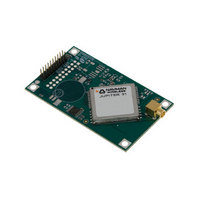AA003041-G Navman Wireless, AA003041-G Datasheet - Page 8

AA003041-G
Manufacturer Part Number
AA003041-G
Description
MODULE JUPITER 31 GPS W/R/A OSX
Manufacturer
Navman Wireless
Specifications of AA003041-G
Frequency
1.575GHz
Sensitivity
-159dBm
Modulation Or Protocol
GPS
Applications
GPS
Data Interface
Connector, 2 x 10 Header, 2 mm Pitch
Antenna Connector
OSX
Voltage - Supply
3.3V
Operating Temperature
-40°C ~ 85°C
Package / Case
Module
Lead Free Status / RoHS Status
Lead free / RoHS Compliant
Features
-
Memory Size
-
Data Rate - Maximum
-
Current - Receiving
-
Other names
943-1007
For further information on power management modes refer to the Low Power Operating Modes
application note (LA000513).
3.5 Differential aiding
3.6 Navigation modes
The Jupiter 31 GPS receiver supports 3D (three-dimensional) and 2D (two-dimensional) modes
of navigation.
3D navigation: the receiver defaults to 3D navigation when at least four GPS satellites are
being tracked. In 3D navigation, the receiver computes latitude, longitude, altitude, and time
information from satellite measurements.
2D navigation: when less than four GPS satellite signals are available, or when a fixed altitude
value can be used to produce an acceptable navigation solution, the receiver will enter 2D
navigation using a fixed value of altitude determined by the host. Forced operation in 2D mode
can be commanded by the host.
In 2D navigation, the navigational accuracy is primarily determined by the relationship of the
fixed altitude value to the true altitude of the antenna. If the fixed value is correct, the specified
horizontal accuracies apply. Otherwise, the horizontal accuracies will degrade as a function of
the error in the fixed altitude.
3.7 Core processor performance
The standard Jupiter 31 runs at a CPU clock speed of up to 50 MHz. An SDK (Software
Development Kit) is available from SiRF to customise the Jupiter 31 firmware.
LA010811B © 2008 Navman Wireless OEM Solutions. All rights reserved. Proprietary information and specifications subject to change without notice.
3.4.1 Adaptive TricklePower
The Jupiter 31 can use the Adaptive TricklePower (ATP) feature, which reduces power
consumption by intelligently switching between full power in tough GPS environments and
low power in strong GPS signal areas.
When signal levels drop, the receiver returns to full power so that message output rates
remain constant. This results in variable power savings but much more reliable performance
for a fixed output rate. Applications using ATP should give performance very similar to full
power, but with significant power savings in strong signal conditions.
ATP is best suited for applications that require solutions at a fixed rate as well as low power
consumption and still maintain the ability to track weak signals.
With ATP at a 1 second update, a power saving of 50% can easily be achieved with minimal
degradation in navigation performance.
3.4.2 Push-To-Fix
Unlike TricklePower, the operation in this mode is not cyclic. This mode always forces the
GPS software to revert to a continuous sleep mode after a navigation position fix. It will stay
in sleep mode until woken by activation of the reset input, and compute a fresh position.
If the ephemeris data becomes invalid, the RTC has the ability to self activate and refresh the
data, thus keeping the restart TTFF very short.
This mode yields the lowest power consumption of the module, and is ideal where a battery
powered application requires very few position fixes.
3.5.1 Differential GPS (DGPS)
DGPS is not available on the Jupiter 31.
3.5.2 Satellite Based Augmentation Systems, (SBAS)
The Jupiter 31 is capable of receiving SBAS differential corrections including WAAS,
EGNOS and MSAS. SBAS improves horizontal position accuracy by correcting GPS signal
errors caused by ionospheric disturbances, timing and satellite orbit errors.
TM
mode
TM
mode























